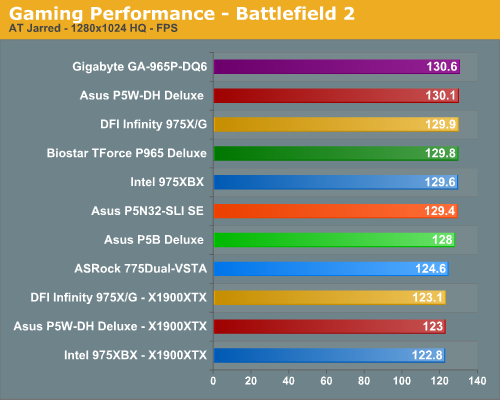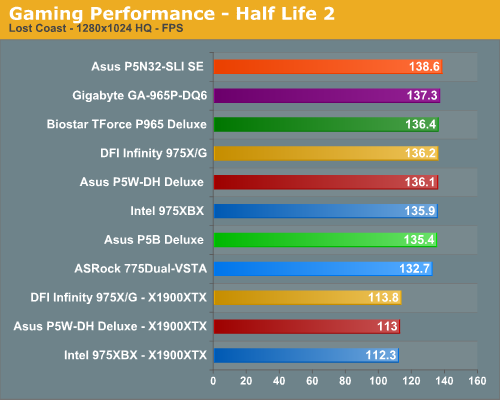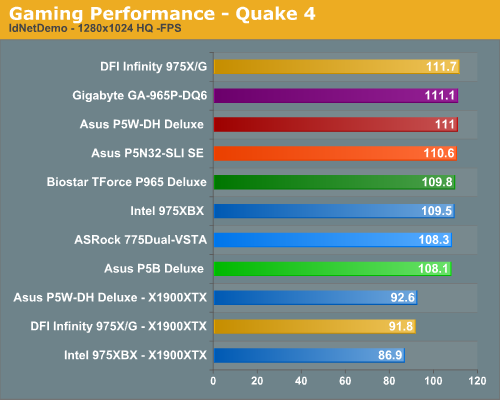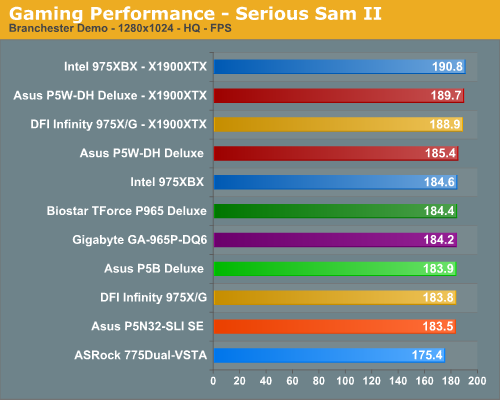Conroe Buying Guide: Feeding the Monster
by Gary Key & Wesley Fink on July 19, 2006 6:20 AM EST- Posted in
- Motherboards
Standard Gaming Performance
We tested with a small group of games due to time constraints, but we picked games based on a variety of game engines to give a quick indication of the boards' performance. Additional testing will be done in our full board reviews but for this roundup we are using Serious Sam 2, Half Life 2: Lost Coast, F.E.A.R, Quake 4, and Battlefield 2. All boards were tested with the EVGA 7900GTX using NVIDIA 91.31 WHQL drivers. The Intel 975X boards were also tested with a single ATI X1900XTX card with the Catalyst 6.6 driver.





The two most performance oriented boards in our roundup are the ASUS P5W-DH and Gigabyte GA-965P-DQ6 boards, and they complete our gaming benchmarks with scores at or near the top of each game category. The most consistent board in the roundup is the Biostar TForce P965 Deluxe that stayed the course throughout testing by remaining in the middle sector of the group. Although the Biostar board did not finish first, it also did not have swings where it was at the top of one benchmark and near the bottom on another one. The ASRock board finished last among the 7900GTX boards four times and second to last on the Quake 4 test where it had its best showing. Overall, the scores generated by this group of boards are so close that you would be hard pressed to actually see or feel the difference in real game play.
The ATI X1900XTX cards finished significantly behind the NVIDIA cards in Half Life 2: Lost Coast where they generally score even or ahead of NVIDIA depending upon game settings. While their performance in the DOOM 3 engine games are normally several percentage points behind the NVIDIA based cards until recently, the difference in our Quake 4 test is also perplexing with the current 6.6 driver release. We ran our ATI X1900XTX in the ASUS P5N32-SLI board and the percentage differences between the GPUs were the same that we see on the AMD S939 or AM2 platforms. It appears to us at this time there is an ATI driver bug with the current Intel chipsets and Core 2 Duo, or perhaps a lack of optimization.
We tested with a small group of games due to time constraints, but we picked games based on a variety of game engines to give a quick indication of the boards' performance. Additional testing will be done in our full board reviews but for this roundup we are using Serious Sam 2, Half Life 2: Lost Coast, F.E.A.R, Quake 4, and Battlefield 2. All boards were tested with the EVGA 7900GTX using NVIDIA 91.31 WHQL drivers. The Intel 975X boards were also tested with a single ATI X1900XTX card with the Catalyst 6.6 driver.





The two most performance oriented boards in our roundup are the ASUS P5W-DH and Gigabyte GA-965P-DQ6 boards, and they complete our gaming benchmarks with scores at or near the top of each game category. The most consistent board in the roundup is the Biostar TForce P965 Deluxe that stayed the course throughout testing by remaining in the middle sector of the group. Although the Biostar board did not finish first, it also did not have swings where it was at the top of one benchmark and near the bottom on another one. The ASRock board finished last among the 7900GTX boards four times and second to last on the Quake 4 test where it had its best showing. Overall, the scores generated by this group of boards are so close that you would be hard pressed to actually see or feel the difference in real game play.
The ATI X1900XTX cards finished significantly behind the NVIDIA cards in Half Life 2: Lost Coast where they generally score even or ahead of NVIDIA depending upon game settings. While their performance in the DOOM 3 engine games are normally several percentage points behind the NVIDIA based cards until recently, the difference in our Quake 4 test is also perplexing with the current 6.6 driver release. We ran our ATI X1900XTX in the ASUS P5N32-SLI board and the percentage differences between the GPUs were the same that we see on the AMD S939 or AM2 platforms. It appears to us at this time there is an ATI driver bug with the current Intel chipsets and Core 2 Duo, or perhaps a lack of optimization.










123 Comments
View All Comments
Gary Key - Wednesday, July 19, 2006 - link
I am surprised I did not see this posted on a news site somewhere announcing Intel has a X6600. ;-) The line was corrected this morning to (X6800, E6700, E6600) although late last night my mind was probably thinking unlocked E6600 equals X6600 for some reason. Thanks for the notice! :)
drarant - Wednesday, July 19, 2006 - link
In recent months the memory market has moved from a 1GB kit to a 2BG kit being the common memory configuration.2GB*
Excellent article, I'm assuming the OCing results were default voltages on the chipsets and/or the cpu?
drarant - Wednesday, July 19, 2006 - link
page 11, 2nd to last sentence*Patsoe - Wednesday, July 19, 2006 - link
To be honest, I would say it's quite different!
The storage controllers have been changed a lot... there is now a port-multiplier type of SiI chip that connects to one of the ICH7 ports, which provides driverless (!) RAID. Also, the previous board had a Marvell SATA/PATA controller instead of the JMicron controller.
For another difference: the new board is missing the PCIe 4x slot, too.
Anyway, thanks for the great overview! And it's amazing how fast after launch you got this up.
Wesley Fink - Wednesday, July 19, 2006 - link
Thanks for your comment. We added information to the P5W-DH page with a little more info on the differences from the earlier board.nicolasb - Wednesday, July 19, 2006 - link
...is what is the actual impact on system performance of different memory speeds and timings? Possibly you guys actually derive a direct erotic thrill simply from knowing that your memory timings are 4-3-3-9 ;-) but what the rest of us care about is whether any given timings actually provide a tangible improvement to running applications. If I spend an extra £200 on memory, am I going to get an extra 10fs in a certain game, or just an extra 1fps if I'm lucky? That's what I want to know.Conroe is a new chip and it is by no means obvious (to me, anyway) whether the speed/latency of the memory will have a greater or lesser impact on the performance of the system than is the case for Netburst or A64 chips.
So, how about re-running some of your benchmarks on one particular board and producing results for different memory speeds and latencies?
Wesley Fink - Wednesday, July 19, 2006 - link
The original plan was to publish a Conroe memory article prior to this huge motherboard and memory roundup. The move forward of the Conroe launch by two weeks shifted our schedule quite a bit, as we discussed in the Buying Guide. we have found the timings DDR2 memory can achieve give a rough idea of the performance hierarchy on Conroe. That is 1067 at 4-4-4 is a bit faster than 800 at 3-3-3 is faster than 667 3-2-3. 667 is generally faster than nything slower regardless of timings.With 13 DDR2 kits it was impossible to do proper and complete performance testing on all the memory on Conroe and still deliver an article when you want to read it. There will definitely be followup reviews of memory on Conroe anwsering your questions in detail. We knew there would be complaints from some, but we also hoped you could understnad the roundup is posting 4 days after an early Conroe launch - and you can't even buy Core 2 Duo until 7/27 or later.
We wanted to provide solid info as soon as possible for those planning a Conroe purchase. We thought our finding that almost any Elpida value DDR2 will do DDR2-800 4-3-3 at about 2.2v was big news you would want to know, we will fill in the rest of the performance data as soon as we can.
As it is the roundup is over 15,000 words and one of the largest articles ever published at AT - in word length - and we really tried to be brief in each review. We really like giving our readers exactly what they want, but sometimes the realities of time and volume shift our priorities.
Tanclearas - Thursday, July 20, 2006 - link
Although I can understand what you're saying, maybe the following should not have been included in the introductory page.I guess the only surprise was that the comparison wasn't there. :P
Honestly, I tried to jump right to that section only to find rather useless comparisons of ridiculously expensive memory (which I won't buy) and "value" (read cheap) memory (which I won't buy). Also, can you really tell me that it was much of a surprise that the expensive memory all topped out at roughly the same speed (~1100, 5-5/4-5-15)? Nor am I particularly surprised the value memory could overclock reasonably well, but how about tests of the memory that I think most of your readers are likely to buy? I've been looking at DDR2, and you can get memory rated at DDR2-800 for a little more than the DDR2-667/533 variety, and still a lot less than the DDR2-1000 modules.
I know that you were pressed for time, especially with the launch being pushed forward. I just think (and it is only an opinion) that other tests should have been given priority over the ones you've completed.
kmmatney - Wednesday, July 19, 2006 - link
Also, what motherboard was used for the DDR tests? Often, value RAM is paired with a "value" motherboard. Value RAM may not look so well when paired with a value motherboard. I'm wondering how cheap we can go for reasonable peformance :)Gary Key - Wednesday, July 19, 2006 - link
We stated at the end of page 18 that we will be publishing performance results of the value memory roundup shortly. The amount of time required to test these seven modules at four different settings in several different applications was incredible and warrants a separate article update.